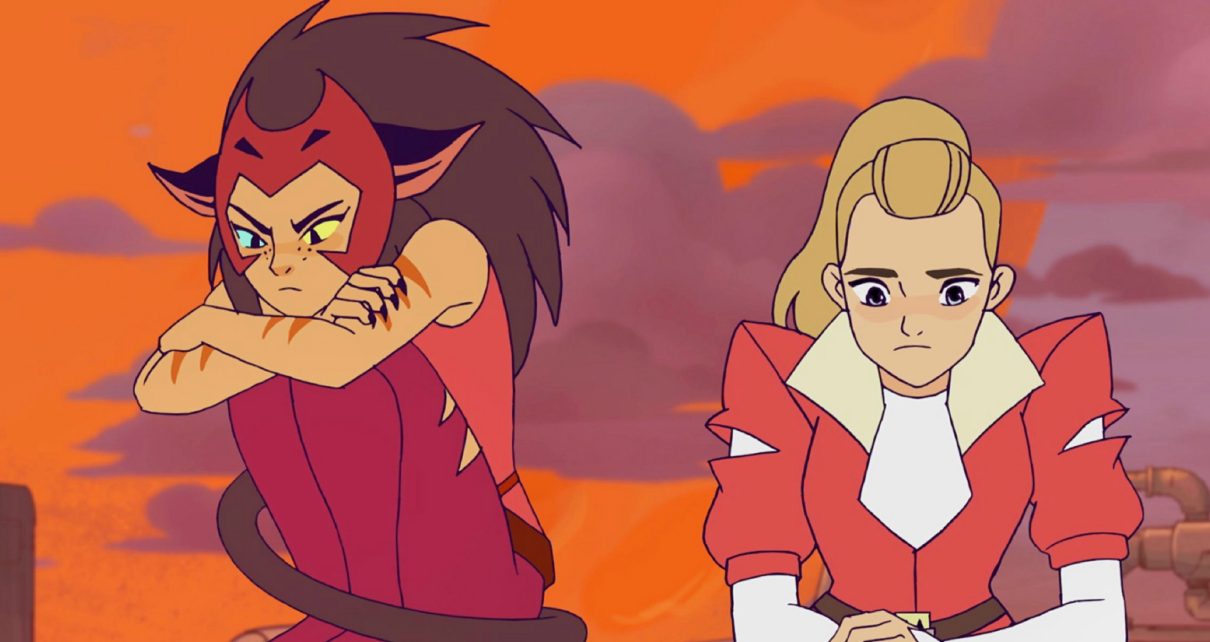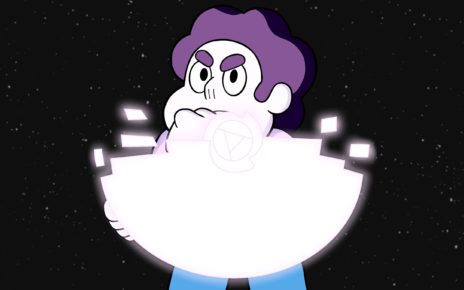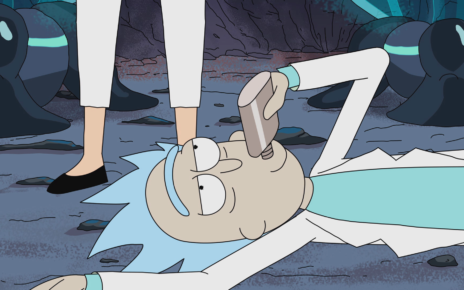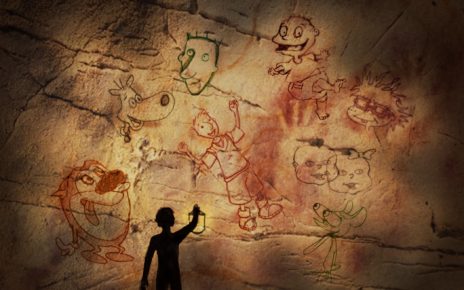“Hey, Adora.”
There’s a lot to love in She-Ra and the Princesses of Power from Dreamworks and Netflix, the reboot of the 1985 He-Man and the Masters of the Universe spin-off She-Ra: Princess of Power. It boasts a bright color palette, a consciously diverse cast of characters, and a team of women and LGBTQ+ allies fighting encroaching evil.
But I’m here to talk about the queer.
Recent years have delivered an array of queer cartoons, much longed for, that have broken serious ground in how we present love, identity, gender, and sexuality to young audiences, most famously The Legend of Korra, Adventure Time, and Steven Universe. These shows not only prominently feature queer characters and relationships but actively challenge heteronormativity throughout. The very texture and rhythm of a storyline is different when you center women and queerness.
She-Ra has all of this. I feel safe (and seen) with Bow and Seahawk, both the Horde and the Rebellion have powerful matriarchs, and the story is predicated on different kinds of princesses showcasing the endless multitudes of strengths and weaknesses a person can have. In the blatant absence of patriarchy and toxic masculinity (except in the leader of the Evil Horde, Hordak), everyone is revealed to be messy and complex. No one, from the heroic Glimmer to the wicked Shadow Weaver, is one-dimensional—least of all the flawed, feline, painfully relatable villain Catra.
Where Steven Universe and Korra grant us romantic, healthy depictions of queer girls and nonbinary women falling in love, the dynamic between Catra and Adora is distinctly messier. Queer representation needs both.
This isn’t to excuse the monstrosity Catra commits. She feels utterly betrayed that Adora ultimately chooses to abandon the Horde to fight against it alongside Bow and Glimmer, and that Adora’s decision was made before she took Catra into consideration. Adora was, arguably, right to do so, prioritizing justice over personal relationships. In fact, it’s exactly what the Horde trained her to do, except Adora confronts the reality that she’s been fighting on the wrong side of justice since she was brought into the Horde as a baby. The Horde trains its soldiers to believe Princesses are evil, murderous creatures, and Adora discovers the dark truth behind those lies.
But Catra doesn’t care about any of that. More than almost anything, Catra hates feeling vulnerable. The Horde trained her to perceive vulnerability as weakness, and Catra knows her vulnerability is her closeness to Adora — so she claws at that place in her heart, scarring it. Her inability to let Adora go ends up revealing the intensity of her feelings, which come to a head at Princess Prom.
What was supposed to be a neutral zone turns into a disaster as Catra manipulates Adora and endangers every Princess in attendance. For Catra, the manipulation is just as significant as the destruction—she wanted to prove that Adora cared enough to be distracted by her former friend, an admittedly stunning suit, and some iconic dance moves. She wanted to prove that she was in control, that she wasn’t vulnerable. And yes, Catra was toying with her, but she also definitely wanted to dance with Adora. (It’s so gay, guys. It’s so good.)
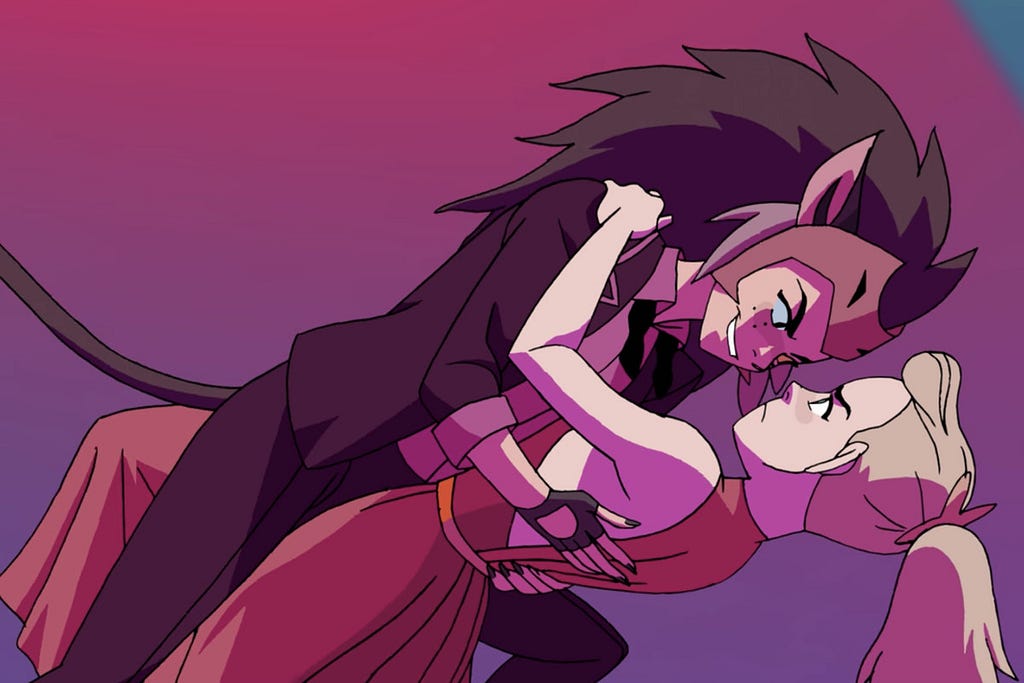
Catra’s villainy comes about through Shadow Weaver’s abuse, her envy of Adora and her superior status as a soldier, and loneliness, but it’s villainy nonetheless. She demonstrates a lack of utter selfishness, which veers quickly into cruelty.
And it’s absolutely excellent storytelling.
Men are allowed to be this kind of villain. Brooding, selfish, and violent—that’s like, nine out of ten teen heartthrobs from the 1990s. Women manifesting the same sort of energy are usually written off as unlikable, and She-Ra balks at this. Catra is too fraught and compelling to not be sympathetic.
Catra’s complexity also allows for greater potency in the dynamic between her and Adora, because their relationship, unlike in the original iteration of the show, is fraught and tenderly tangled. They’ve both betrayed each other, which is way more interesting than Catra just choosing to be evil for the hell of it.
Listen. I may not have endangered an entire Princess Prom because my best friend—who is totally not the most important person in the world to me because love is weakness and weakness is failure and failure is death and I am stronger than that!, in case you were wondering—chose to hang out with someone else.
But I have been head over heels in something I never would have called love for a straight friend who was so much more to me than that. Something that, at the time, I couldn’t name. Somewhere between envy at how obviously beautiful she was, the kind of beauty and strength no one has to look hard for, and a fierce, frustrated longing. Those can combine into a frenzied rage simmering just below the surface. Because the very last thing you want from that person, worse than rejection or disgust, is pity. And when she, innocently, ignorantly, makes it clear that other people mean just as much to her as you do, sometimes even more, there are many places a heart can go. Many vices a person can turn to. Catra took the only path that, outside of where she could have gone with Adora, she had ever known: sweet, vicious retribution.
They’re not pretty feelings. They’re not clean, and they’re not fair. But they’re also painfully familiar to plenty of queer people who were been raised in an environment that treats love or rebellion as weakness. In that, the Horde, to those of us in the queer community, should feel very familiar to many, many places in this world.
It’s all the more excruciating that there is a place that would allow Catra to be the best she could be, and even be with Adora however they chose— the Resistance, a collection of individuals working to rebuild the Princess Alliance. It’s filled with all kinds of women who manifest many different ways of being strong. It’s a safe, inclusive space, and two Princesses, Spinnerella and Netossa, are already canonically a couple. Adora asks, more than once, for Catra to join her. But it’s too little, too late. Adora has already made her choice to leave the Horde, even if it meant leaving Catra behind, and that’s all Catra cares about.
What Catra doesn’t understand is that Adora does want them to fight for the same side, just not at the expense of siding with the Horde, of sacrificing innocent lives. For Catra, it’s always been the two of them against the world. Nothing else would have mattered. To be an afterthought when someone is your universe, to know that she doesn’t need you the same way you need her, but she’s willing to reach out a hand when she thinks you need it —it’s not pity, necessarily, because Catra’s not willing to outright express how much Adora’s actions felt like a betrayal, but when you don’t know how to process your emotions, oh, it sure feels like it. In its most heartbreaking, humiliating, irredeemable form.
So Catra fights back, at first to prove she never needed Adora in the first place, then to prove she’s stronger than Adora after all, than anyone in the Horde. She’s coming from a place of utter betrayal, and even though she’s exaggerated Adora’s intentions, Adora’s actions injure her more than she is willing to admit. She lashes out, not caring who she hurts, wanting to inflict as much pain on Adora as possible without actually physically hurting her, wanting to burn the world down so she can say, this is what I am capable of without you when what she means is this is what it feels like you have done to me, and this is what I will become without you, and arguably, the even more petulant this is how much I care.
Adora doesn’t hear everything Catra isn’t saying, but she hears a lot of it, and she doesn’t want to give up. As they’re trapped in the Beacon, fighting off AI together, she apologizes for leaving, emphasizing that she just couldn’t return to the Horde once she knew the truth, crying: I never wanted to leave you! But she already has, and Catra can’t forget that, and Catra finds so embarrassing the extent to which she cares. The tension between them works like a live wire: these two powerful fighters, trained through the same techniques, unable to forget about each other, unwilling to back down. Each made the other who they are. It forms an effective through-line: Catra’s calculated, frenetic cruelty and Adora’s desire to undo the wrongs she once militantly defended, all crashing against their relationship.
I’m very sensitive to the queer-coded villain trope. It’s exhausting, harmful, often racist, and it is not representation. I’m open to pushback about this, but I think the reason I don’t feel Catra falls into this trap is because the very fabric of the show is so queer, homonormative, and inclusive. She’s not a stereotype because she’s not first-and-only —she’s one of canonically a few and subtextually many, which I feel confident will emerge out of subtext into context sooner rather than later in upcoming seasons. She-Ra: Princesses of Power allows for Catra’s messy queerness because it knows it’s not the only kind of queerness there is, and it knows how brutally relatable it is for so many queer folks just trying to convince themselves they have put their pain behind them. I don’t miss you. I don’t miss you. You leaving was the best thing that ever happened to me. I wonder who I could’ve been if I’d just gotten rid of you sooner.
If there is a path towards redemption for Catra, it’s a thorny one, and requires her to sincerely earn forgiveness from the many people she’s hurt. She’ll need to actively be part of the healing and the fight against the Horde. That might take a long time, but by the honor of Grayskull, I am ready for the ride! Because if she can find her way back, she’ll show so many closeted, aching queer kids that hurting people isn’t the kind of power that makes you feel better—and that caring about others isn’t a weakness, but the ultimate strength.
And if Catra never gets a redemption arc, her character still proves all those truths! And that would leave her, arguably, as one of the most compelling antagonists and well-written women on children’s TV.
I can live with that. Promise.
She-Ra: Princesses of Power returns to Netflix April 26.
Thanks for reading The Dot and Line, where we talk about animation of all kinds. Don’t forget to follow us on Twitter and sign up for our newsletter.


